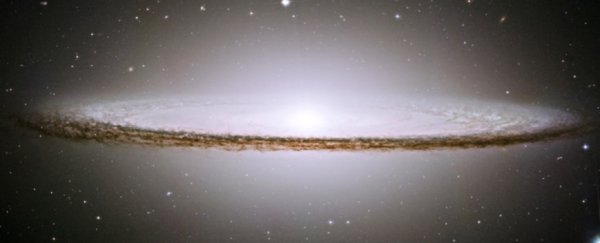The foundation stone of quantum mechanics doesn't just describe the behaviour of infinitesimal subatomic particles – it also governs the movement of the largest and most massive objects in the Universe, says a prominent astrophysicist.
Einstein's theory of general relativity is often considered the reliable lynchpin of physics at the astronomical scale, but planetary scientist Konstantin Batygin (of Planet Nine fame) says quantum mechanics can also describe the evolution of mind-bendingly massive objects in space, as amazing as that sounds.
During teaching of planetary physics at Caltech, Batygin was exploring the concept of astrophysical disks – sometimes called accretion disks – massive self-gravitating swirls of matter that Batygin describes as being "among the most ubiquitous objects in the known Universe".
That's because these kinds of disks form seemingly everywhere: planets orbit stars forming solar systems, which in turn orbit supermassive black holes at galactic centres.
But while these disks may start off with a circular shape, over epic stretches of time they can ripple and warp, exhibiting vast distortions that still can't be definitively explained by astrophysicists.
It's a galaxy away from what's called the Schrödinger equation – the mathematical centrepiece of quantum mechanics – named after Austrian physicist Erwin Schrödinger.
"[Schrödinger] realised that you can't describe electrons or atoms or any of the other smallest pieces of the Universe as billiard balls that will be exactly where you expect them to be exactly when you expect them to be there," Brendan Cole explained for ScienceAlert in 2016.
"Instead, you have to assume that particles have positions that are spread out in space, and that they only have some probability of appearing where you think they're going to be at any point in time."
This phenomenon, expressed in what became known as the Schrödinger equation when it was published in 1926, describes a particle's state in terms of a wave function.
But according to Batygin's new research – coming almost a century later – the equation isn't just for describing particles. Much, much bigger things are also seemingly governed by these quantum calculations.
While investigating an area of quantum physics called perturbation theory to see how it could mathematically represent the forces in astrophysical disk evolution, explaining how these vast objects warp over aeons, Batygin discovered something remarkable.
In the theory, an astrophysical disk can be modelled as a series of concentric wires that slowly exchange orbital angular momentum among one another.
Given the immense scope and size of these disks – and the staggering amount of planets, stars, and galactic structures contained within them – it can get pretty complex, and that's when the modelling revealed an amazing twist.
"When we do this with all the material in a disk, we can get more and more meticulous, representing the disk as an ever-larger number of ever-thinner wires," Batygin explains.
"Eventually, you can approximate the number of wires in the disk to be infinite, which allows you to mathematically blur them together into a continuum. When I did this, astonishingly, the Schrödinger equation emerged in my calculations."
According to Batygin, the large-scale warps that distort astrophysical disks over time behave similarly to particles, and the way they propagate within the disk material can be explained by the same mathematics that govern what's called quantum scattering theory.
Batygin acknowledges that this application of Schrödinger's equation "cannot serve as a general replacement for more complex numerical simulations … [but] can be meaningfully used to provide qualitative context for numerical results".
Nonetheless, it's amazing to think an equation used to describe the behaviour of things so small you can't see them, can also apply to the behaviour of esoteric gravitational forces so vast and distant that scientists are only now beginning to comprehend them.
"This discovery is surprising because the Schrödinger equation is an unlikely formula to arise when looking at distances on the order of light-years," says Batygin.
"In a sense, the waves that represent the warps and lopsidedness of astrophysical disks are not too different from the waves on a vibrating string, which are themselves not too different from the motion of a quantum particle in a box.
"In retrospect, it seems like an obvious connection, but it's exciting to begin to uncover the mathematical backbone behind this reciprocity."
The findings are reported in Monthly Notices of the Royal Astronomical Society.
